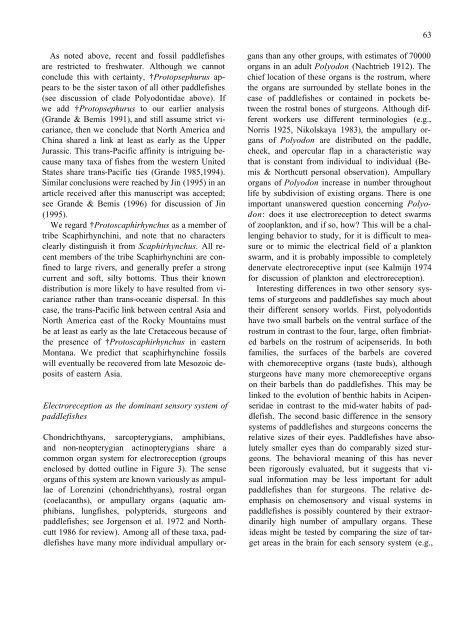Sturgeon biodiversity and conservation
Sturgeon biodiversity and conservation
Sturgeon biodiversity and conservation
Create successful ePaper yourself
Turn your PDF publications into a flip-book with our unique Google optimized e-Paper software.
As noted above, recent <strong>and</strong> fossil paddlefishes<br />
are restricted to freshwater. Although we cannot<br />
conclude this with certainty, †Protopsephurus appears<br />
to be the sister taxon of all other paddlefishes<br />
(see discussion of clade Polyodontidae above). If<br />
we add †Protopsephurus to our earlier analysis<br />
(Gr<strong>and</strong>e & Bemis 1991), <strong>and</strong> still assume strict vicariance,<br />
then we conclude that North America <strong>and</strong><br />
China shared a link at least as early as the Upper<br />
Jurassic. This trans-Pacific affinity is intriguing because<br />
many taxa of fishes from the western United<br />
States share trans-Pacific ties (Gr<strong>and</strong>e 1985,1994).<br />
Similar conclusions were reached by Jin (1995) in an<br />
article received after this manuscript was accepted;<br />
see Gr<strong>and</strong>e & Bemis (1996) for discussion of Jin<br />
(1995).<br />
We regard †Protoscaphirhynchus as a member of<br />
tribe Scaphirhynchini, <strong>and</strong> note that no characters<br />
clearly distinguish it from Scaphirhynchus. All recent<br />
members of the tribe Scaphirhynchini are confined<br />
to large rivers, <strong>and</strong> generally prefer a strong<br />
current <strong>and</strong> soft, silty bottoms. Thus their known<br />
distribution is more likely to have resulted from vicariance<br />
rather than trans-oceanic dispersal. In this<br />
case, the trans-Pacific link between central Asia <strong>and</strong><br />
North America east of the Rocky Mountains must<br />
be at least as early as the late Cretaceous because of<br />
the presence of †Protoscaphirhynchus in eastern<br />
Montana. We predict that scaphirhynchine fossils<br />
will eventually be recovered from late Mesozoic deposits<br />
of eastern Asia.<br />
gans than any other groups, with estimates of 70000<br />
organs in an adult Polyodon (Nachtrieb 1912). The<br />
chief location of these organs is the rostrum, where<br />
the organs are surrounded by stellate bones in the<br />
case of paddlefishes or contained in pockets between<br />
the rostral bones of sturgeons. Although different<br />
workers use different terminologies (e.g.,<br />
Norris 1925, Nikolskaya 1983), the ampullary organs<br />
of Polyodon are distributed on the paddle,<br />
cheek, <strong>and</strong> opercular flap in a characteristic way<br />
that is constant from individual to individual (Bemis<br />
& Northcutt personal observation). Ampullary<br />
organs of Polyodon increase in number throughout<br />
life by subdivision of existing organs. There is one<br />
important unanswered question concerning Polyodon:<br />
does it use electroreception to detect swarms<br />
of zooplankton, <strong>and</strong> if so, how? This will be a challenging<br />
behavior to study, for it is difficult to measure<br />
or to mimic the electrical field of a plankton<br />
swarm, <strong>and</strong> it is probably impossible to completely<br />
denervate electroreceptive input (see Kalmijn 1974<br />
for discussion of plankton <strong>and</strong> electroreception).<br />
Interesting differences in two other sensory systems<br />
of sturgeons <strong>and</strong> paddlefishes say much about<br />
their different sensory worlds. First, polyodontids<br />
have two small barbels on the ventral surface of the<br />
rostrum in contrast to the four, large, often fimbriated<br />
barbels on the rostrum of acipenserids. In both<br />
families, the surfaces of the barbels are covered<br />
with chemoreceptive organs (taste buds), although<br />
sturgeons have many more chemoreceptive organs<br />
on their barbels than do paddlefishes. This may be<br />
linked to the evolution of benthic habits in Acipen-<br />
Electroreception as the dominant sensory system of seridae in contrast to the mid-water habits of padpaddlefishes<br />
dlefish. The second basic difference in the sensory<br />
systems of paddlefishes <strong>and</strong> sturgeons concerns the<br />
Chondrichthyans, sarcopterygians, amphibians, relative sizes of their eyes. Paddlefishes have abso<strong>and</strong><br />
non-neopterygian actinopterygians share a lutely smaller eyes than do comparably sized sturcommon<br />
organ system for electroreception (groups geons. The behavioral meaning of this has never<br />
enclosed by dotted outline in Figure 3). The sense been rigorously evaluated, but it suggests that viorgans<br />
of this system are known variously as ampul- sual information may be less important for adult<br />
lae of Lorenzini (chondrichthyans), rostral organ paddlefishes than for sturgeons. The relative de-<br />
(coelacanths), or ampullary organs (aquatic am- emphasis on chemosensory <strong>and</strong> visual systems in<br />
phibians, lungfishes, polypterids, sturgeons <strong>and</strong> paddlefishes is possibly countered by their extraorpaddlefishes;<br />
see Jorgenson et al. 1972 <strong>and</strong> North- dinarily high number of ampullary organs. These<br />
cutt 1986 for review). Among all of these taxa, pad- ideas might be tested by comparing the size of tardlefishes<br />
have many more individual ampullary or- get areas in the brain for each sensory system (e.g.,<br />
63
















